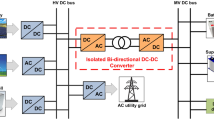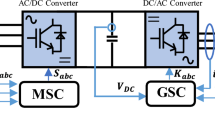Abstract
This paper proposes a methodology for single-phase power factor correction with DC–DC single-ended primary inductance converter (SEPIC) using cascade control strategy which comprises of genetic algorithm-based outer PI controller and an inner current controller which uses an adaptive neuro-fuzzy inference system-based sliding mode controller. DC–DC SEPIC is a fourth-order converter, and in order to reduce the complexity in controller design, reduced-order model of the original higher-order system is obtained by using Type-I Hankel matrix method. The performance of the proposed system is analysed using MATLAB/Simulink-based simulation studies. In order to ensure the robustness of the proposed controller, the performance parameters such as percentage total harmonic distortion, power factor, % voltage regulation, and % efficiency are analysed. From the simulation results, it is inferred that the proposed method provides efficient tracking of output voltage and effective source current shaping for load, line, and set point variations.








Similar content being viewed by others
References
Yang J-W, Do H-L (2015) Efficient single-switch boost-dual-input flyback PFC converter with reduced switching loss. IEEE Trans Industr Electron 62(12):7460–7468
Poorali B, Adib E (2016) Analysis of the integrated SEPIC-flyback converter as a single-stage single-switch power-factor-correction LED driver. IEEE Trans Industr Electron 63(6):3562–3570
Lu DDC, Iu HHC, Pjevalica V (2009) Single-stage AC/DC boost–forward converter with high power factor and regulated bus and output voltages. IEEE Trans Industr Electron 56(6):2128–2132
Lo YK, Lin CY, Chiu HJ et al (2013) Analysis and design of a push–pull quasi-resonant boost power factor corrector. IEEE Trans Power Electron 28(1):347–356
Chen RT, Chen YY (2006) Single-stage push–pull boost converter with integrated magnetics and input current shaping technique. IEEE Trans Power Electron 21(5):1193–1203
Lu DD, Ki SK (2013) Light-load efficiency improvement in buck-derived single-stage single-switch PFC converters. IEEE Trans Power Electron 28(5):2105–2110
Liu X, Xu J, Chen Z et al (2015) Single-inductor dual-output buck–boost power factor correction converter. IEEE Trans Industr Electron 62(2):943–952
Pavlovic T, Bjazi T, Ban Z (2013) Simplified averaged models of DC–DC power converters suitable for controller design and microgrid simulation. IEEE Trans Power Electron 28(7):3266–3275
Umamaheswari MG, Uma G, Vijayalakshmi KM (2011) Design and implementation of reduced-order sliding mode controller for higher-order power factor correction converters. IET Power Electron 4(9):984–992
Davoudi A, Jatskevich J, Chapman PL et al (2013) Multi-resolution modeling of power electronics circuits using model-order reduction techniques. IEEE Trans Circuits Syst 60(3):810–823
Vishwakarma CB (2014) Modified Hankel matrix approach for model order reduction in time domain. World Acad Sci Eng Technol Int J Math Comput Phys Electr Comput Eng 8(2):404–410
Umamaheswari MG, Uma G, Redline Vijitha S (2012) Comparison of hysteresis control and reduced order linear quadratic regulator control for power factor correction using Dc-Dc cuk converters. J Circuits Syst Comput 21(1):1250002
He Y, Luo FL (2006) Sliding-mode control for DC–DC converter switch constant switching frequency. IEEE Proc Control Theory Appl 153(1):37–45
Umamaheswari MG, Uma G, Isabella LA (2014) Analysis and design of digital predictive controller for PFC Cuk converter. J Comput Electron 13:142–154
Lamar DG, Fernandez A, Arias M, Rodriguez M et al (2008) A unity power factor correction pre regulator with fast dynamic response based on a low-cost microcontroller. IEEE Trans Power Electron 23(2):635–642
Chu G, Tse CK, Wong SC, Tan S-C (2009) A unified approach for the derivation of robust control for boost PFC converters. IEEE Trans Power Electron 24(11):2531–2544
Huber Laszlo, Kumar Misha, Jovanovi Milan M (2015) Performance comparison of PI and P compensation in DSP-based average-current-controlled three-phase six-switch boost PFC rectifier. IEEE Trans Power Electron 30(12):7123–7137
de Melo PF, Gules R, Romaneli EFR, Annunziato RC (2010) A modified SEPIC converter for high-power-factor rectifier and universal input voltage applications. IEEE Trans Power Electron 25(2):310–321
Bodetto Mirko, El Aroudi Abdelali, Cid-Pastor Angel et al (2016) Design of AC-DC PFC higher order converters with regulated output current for low power applications. IEEE Trans Power Electron 31(3):2012–2025
Silva JF (1999) Sliding-mode control of boost-type unity-power-factor PWM rectifiers. IEEE Trans Industr Electron 46(3):594–603
519-2014 - IEEE recommended practice and requirements for harmonic control in electric power systems. Transmission and Distribution Committee of the IEEE Power and Energy Societ, IEEE-SA Standards Board, pp 1–29.
Simonetti DSL, Sebastıan J, Uceda J (1997) The discontinuous conduction mode sepic and cuk power factor preregulators analysis and design. IEEE Trans Industr Electron 44:630–637
Melo PF, Gules R, Romaneli EFR et al (2010) A modified SEPIC converter for high-power-factor rectifier and universal input voltage applications. IEEE Trans Power Electron 25(2):310–321
Mahdavi Mohammad, Farzanehfard Hosein (2011) Bridgeless SEPIC PFC rectifier with reduced components and conduction losses. IEEE Trans Industr Electron 58(9):4153–4160
Lamar DG, Zuniga JS, Alonso AR et al (2009) A very simple control strategy for power factor correctors driving high-brightness LEDs. IEEE Trans Power Electron 24(8):2032–2041
Erickson R, Maksimovic D (2000) Fundamentals of power electronics. Kluwer, Norwell
Ridley R (2006) Analyzing the sepic converter. Power Syst em Design Europe, Denmark, Ballard, pp 14–18
Gu W, Zhang D (2008) Designing a SEPIC converter. Excellent design guidelines, national semiconductor in application note, pp 1–6
Kessal A, Rahmani L (2014) Ga-optimized parameters of sliding-mode controller based on both output voltage and input current with an application in the PFC of AC/DC converters. IEEE Trans Power Electron 29(6):3159–3165
Tulay G, Iskender I, Mamizadeh A (2014) Boost PFC PI control by using heuristic optimization method. IJTPE Publ Int Org IOTPE 6(18):167–171
Mamarelis E, Petrone G, Spagnuolo G (2014) Design of a sliding-mode-controlled SEPIC for PV MPPT applications. IEEE Trans Industr Electron 61(7):3387–3398
Marcos-Pastor Adria, Vidal-Idiarte Enric, Cid-Pastor Angel (2015) Loss-free resistor-based power factor correction using a semi-bridgeless boost rectifier in sliding-mode control. IEEE Trans Power Electron 30(10):5842–5853
Paul Arun K, Mishra JK, Radke MG (1994) Reduced order sliding mode control for pneumatic actuator. IEEE Trans Control Syst Technol 2(3):271–276
Bandyopadhyay B, Alemayehu G, Abera E (2007) Sliding mode control design via reduced order model approach. Int J Autom Comput 04(4):329–334
Goudarzian A, Nasiri H, Abjadi N (2016) Design and implementation of a constant frequency sliding mode controller for a luo converter. Int J Eng Trans Appl 29(2):202–210
Rossetto L, Spiazzi G, Tenti P, Fabiano B et al (1994) Fast response high-quality rectifier with sliding mode control. IEEE Trans Power Electron 9(2):146–152
Malesani L, Rossetto L, Spiazzi G (1995) Performance optimization of Cuk converters by sliding-mode control. IEEE Trans Power Electron 10(3):302–309
Umamaheswari MG, Uma G, Vijayalakshmi K (2013) Analysis and design of reduced-order sliding-mode controller for three-phase power factor correction using cuk rectifiers. IET Power Electron 6(5):935–945
Soltanpour MR, Zolfaghari B, Soltani M (2013) Fuzzy sliding mode control design for a class of nonlinear systems with structured and unstructured uncertainties. Int J Innov Comput Inf Control 9(7):2713–2726
Bououden S, Chadli M, Karimi HR (2013) Fuzzy sliding mode controller design using Takagi–Sugeno modelled nonlinear systems. Hindawi Publishing Corporation Mathematical Problems in Engineering 2013, Article ID 734094
Author information
Authors and Affiliations
Corresponding author
Rights and permissions
About this article
Cite this article
Durgadevi, S., Umamaheswari, M.G. Analysis and design of single-phase power factor corrector with genetic algorithm and adaptive neuro-fuzzy-based sliding mode controller using DC–DC SEPIC. Neural Comput & Applic 31, 6129–6140 (2019). https://doi.org/10.1007/s00521-018-3424-2
Received:
Accepted:
Published:
Issue Date:
DOI: https://doi.org/10.1007/s00521-018-3424-2




